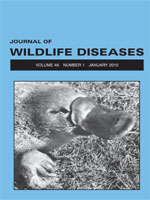Decreases in Greater Sage Grouse (Centrocercus urophasianus) numbers throughout the western United States have been attributed to declining habitat quantity and quality. Improving our understanding of how interannual ecologic site variability affects nutritional status and fitness of different bird age classes will lead to improved land management and conservation strategies. Greater Sage Grouse were sampled from two Population Management Units located in northern Nevada, United States: Tuscarora (TU) and Lone Willow (LW) during 15 March–11 April 2004 and 14–20 March 2005. Twenty (16 yearlings, four adults) and 17 (7 yearlings, 10 adults) female Sage Grouse were captured and bled during 2004, and 12 (four yearlings, eight adults) and 14 (10 yearlings, four adults) were sampled during 2005 in TU and LW, respectively. Samples were evaluated to examine the effect of site, age, and year on specific hematologic and serum chemistry parameters. Several differences between age classes, sites, and years were detected for a number of fitness indicators; however, actual values fell within normal ranges of variation for Sage Grouse or other avian species. Differences were also detected for several parameters more closely related to reproductive fitness, including total plasma and serum proteins, and serum calcium and phosphorus. Yearlings had lower plasma protein (P<0.0001) and lower serum protein than did adults (P=0.0003). In 2004, TU yearlings had lower serum calcium levels than the adults, and in 2005, LW yearlings had lower levels than adults (P=0.008). Females on the TU site had lower serum phosphorus than the LW females (P<0.0001). Overall, adult females weighed more than yearlings (P=0.0004). Lower values found in yearlings, and on the TU management unit, indicate a lower production potential, particularly in unfavorable years. A lower intrinsic ability of yearlings to reproduce, combined with lower nutrition potentials and associated annual variations on certain types of habitat combinations, indicate that conservation measures must be flexible and based on local prescriptions. Fitness parameters of Sage Grouse should be used to assess effects of land management practices and conservation on Sage Grouse populations in order to provide more certainty of the outcome, whether positive, neutral, or deleterious.
How to translate text using browser tools
1 January 2010
SITE AND AGE CLASS VARIATION OF HEMATOLOGIC PARAMETERS FOR FEMALE GREATER SAGE GROUSE (CENTROCERCUS UROPHASIANUS) OF NORTHERN NEVADA
Kathryn J. Dyer,
Barry L. Perryman,
Dale W. Holcombe
ACCESS THE FULL ARTICLE

Journal of Wildlife Diseases
Vol. 46 • No. 1
January 2010
Vol. 46 • No. 1
January 2010
Centrocercus urophasianus
hematologic parameters
Nevada
sage grouse




